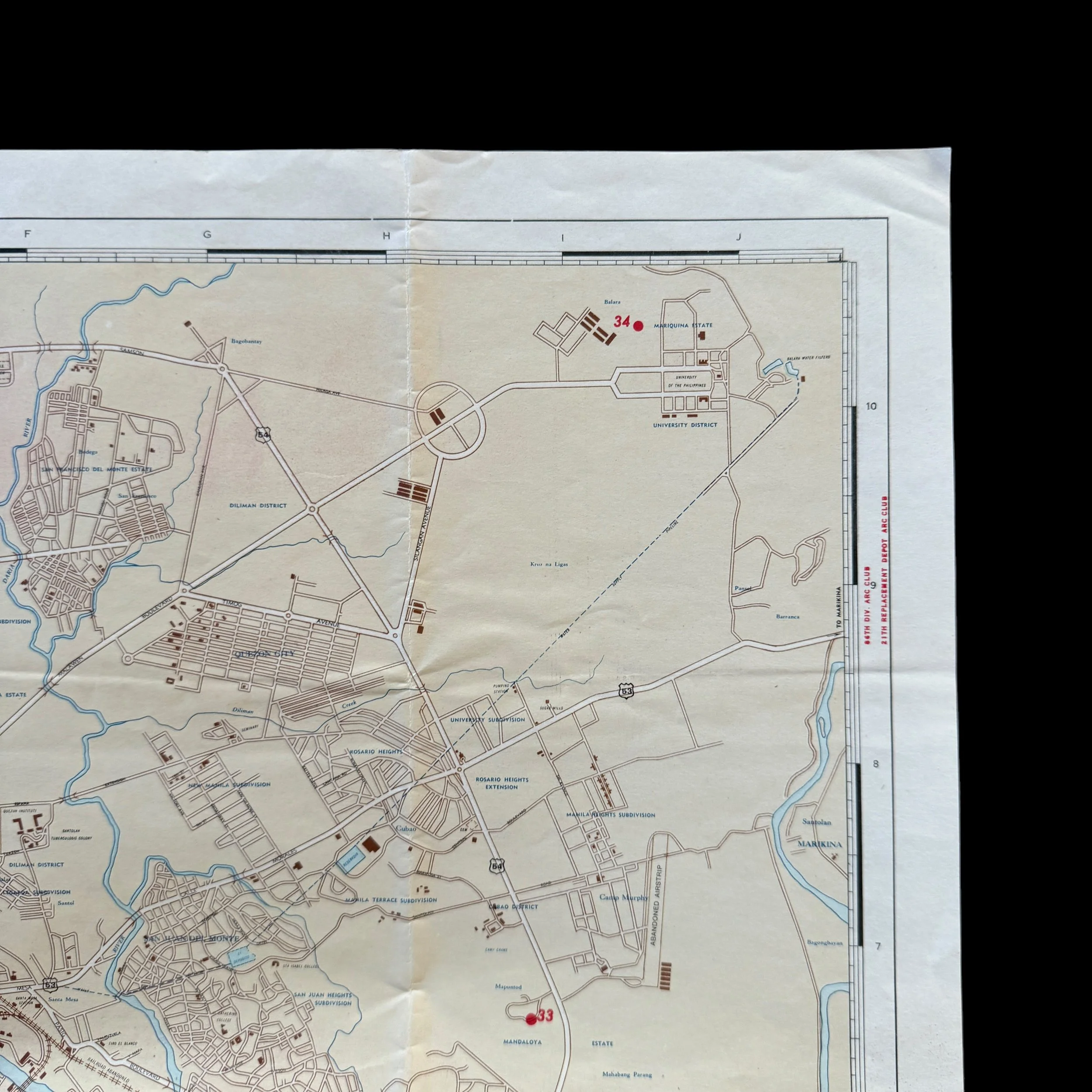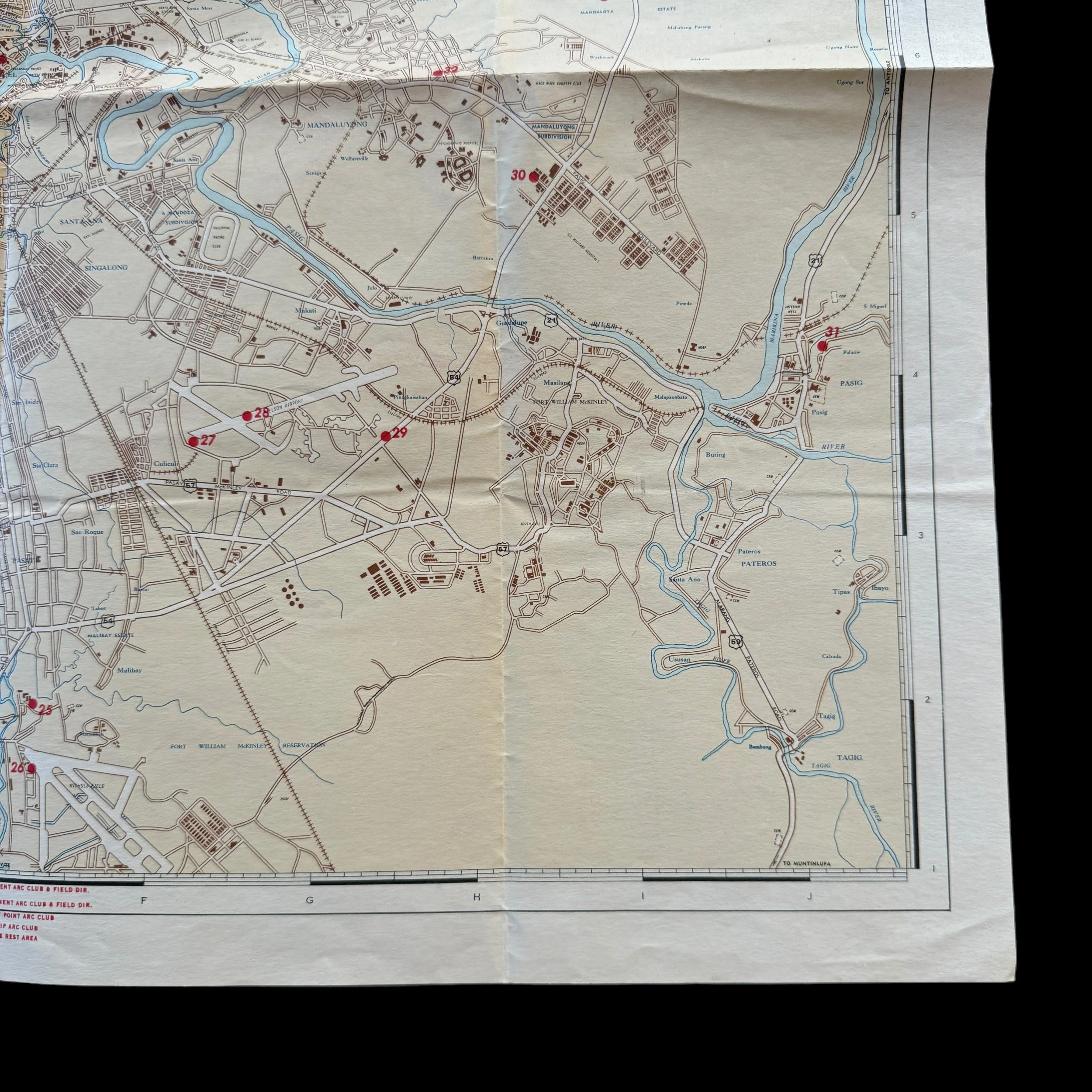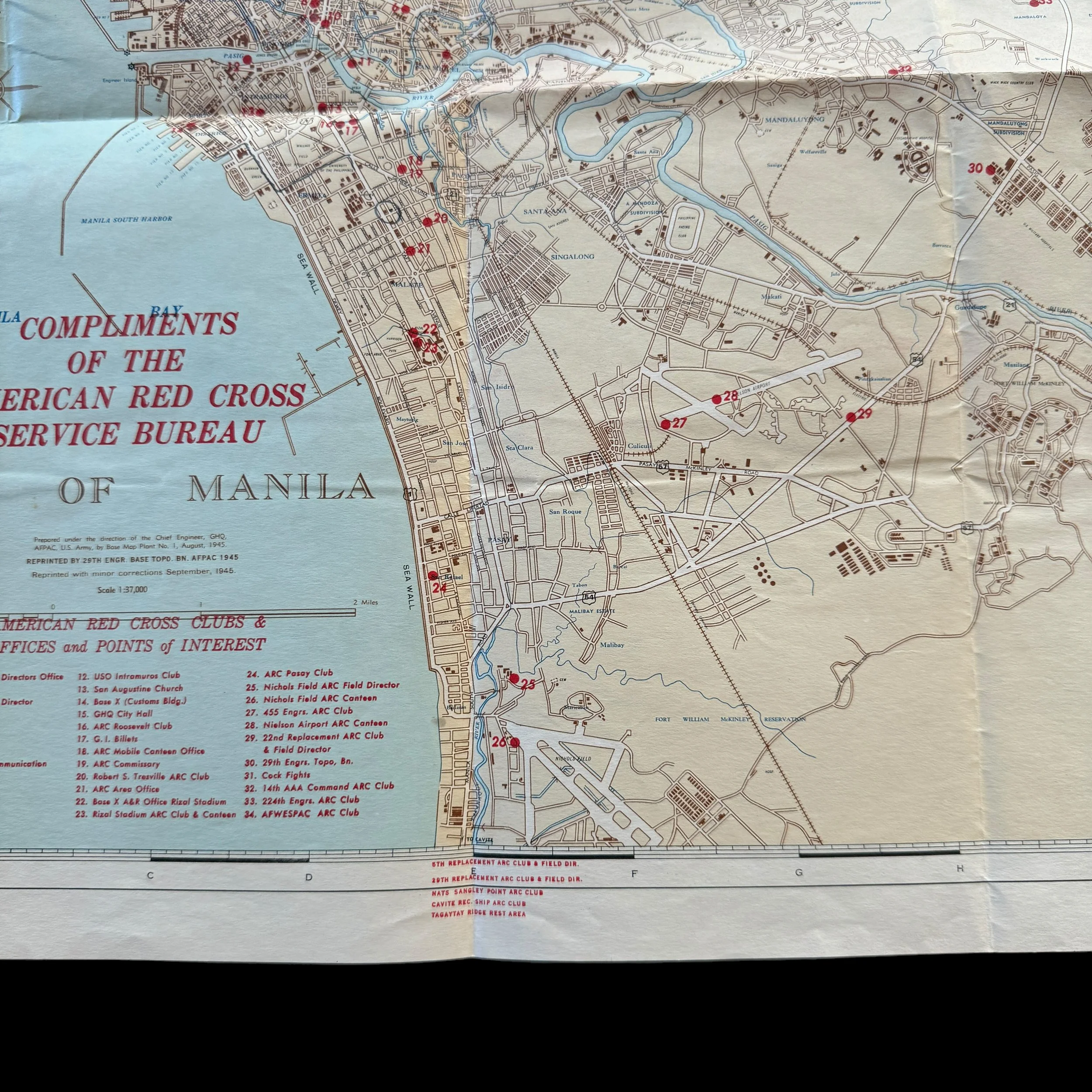WWII September 1945 City of Manila Pacific Theater RED CROSS Map*



























WWII September 1945 City of Manila Pacific Theater RED CROSS Map*
Comes with C.O.A.
This incredible Pacific Theater map of the sounding area of Manila and Manila Bay was prepared under the direction of the Chief Engineer U.S. Army by Base Map Plant No. 1 in August of 1945 with reprinted and minor corrections done in September 1945. This map is a special American Red Cross overprint that details Red Cross facilities in the U.S. occupied city of Manila in the Pacific Theater.
The U.S. liberation of Manila marked the incredible return of General Douglas MacArthur to the Philippines from the infantry D-Day landing beaches in the Lingayen Gulf all the way to the capital city of Manila (the ultimate objective of the amphibious assault landing in Luzon).
The City of Manila during World War II stands as a poignant chapter in the annals of human history, marked by unprecedented destruction, human suffering, and ultimate liberation. As the capital of the Philippines, Manila was a strategic and symbolic target for both the Japanese and Allied forces. The period leading up to 1945 and the subsequent Battle of Manila remain etched in memory due to the extensive devastation and the humanitarian efforts, particularly those by the Red Cross, during this tumultuous time.
The Japanese Occupation
Manila fell to Japanese forces on January 2, 1942, after a fierce battle. The city, once known as the "Pearl of the Orient," quickly became a symbol of Japanese dominance in Southeast Asia. The occupation was marked by widespread atrocities, including executions, forced labor, and severe restrictions on the local population. The Japanese sought to dismantle American and Filipino influence, replacing it with their own cultural and political ideology.
During the occupation, the Japanese established a puppet government, but real power lay with the Japanese military authorities. The Filipino population endured significant hardships, including food shortages, forced labor, and brutal repression of resistance movements. Despite these adversities, underground movements and guerrilla activities persisted, fueled by a deep-seated desire for liberation.
The Return of Allied Forces
In October 1944, General Douglas MacArthur's promise to return to the Philippines began to materialize with the successful invasion of Leyte. By early 1945, Allied forces were poised to liberate Luzon, the largest island in the Philippines, and its capital, Manila. The Battle of Manila, which took place from February 3 to March 3, 1945, was a pivotal and devastating chapter in this campaign.
The Battle of Manila
The Battle of Manila was one of the most ferocious urban battles of World War II. The Japanese, under the command of Rear Admiral Sanji Iwabuchi, chose to defend the city to the last man, transforming Manila into a fortress. The battle plan involved a scorched earth policy, with Japanese forces systematically destroying infrastructure and committing widespread atrocities against the civilian population.
As American and Filipino forces advanced into Manila, they encountered fierce resistance. The Japanese had fortified key positions throughout the city, turning buildings into strongholds and laying extensive mines and booby traps. The urban environment, characterized by dense residential areas, government buildings, and historic sites, became a deadly battlefield.
The fighting led to massive destruction. Iconic landmarks, such as the Legislative Building, the Manila Cathedral, and the University of Santo Tomas, were heavily damaged or destroyed. The intense artillery bombardments and close-quarters combat left much of the city in ruins. The human toll was staggering; estimates suggest that over 100,000 civilians perished during the battle, many of them victims of Japanese massacres and the indiscriminate nature of urban warfare.
The Role of the Red Cross
Amid the chaos and destruction, the Red Cross played a critical role in providing humanitarian aid and relief to the suffering population. The Red Cross, both the International Committee of the Red Cross (ICRC) and local Red Cross organizations, worked tirelessly to alleviate the suffering of civilians caught in the conflict.
During the Japanese occupation, the Red Cross faced significant challenges. The Japanese authorities imposed strict controls on humanitarian activities, limiting the scope of Red Cross operations. Despite these restrictions, the Red Cross managed to provide medical care, distribute food and supplies, and offer support to prisoners of war and interned civilians.
As the Battle of Manila unfolded, the Red Cross's role became even more vital. Hospitals were overwhelmed with casualties, and the need for medical supplies and personnel was dire. The Red Cross set up emergency medical stations and field hospitals to treat the wounded. Volunteers, including doctors, nurses, and local citizens, risked their lives to provide care to those in need.
One of the most notable efforts was at the University of Santo Tomas, which had been converted into an internment camp for Allied civilians during the Japanese occupation. When American forces liberated the camp on February 3, 1945, the Red Cross was instrumental in providing immediate medical assistance and facilitating the evacuation and rehabilitation of the internees. This operation underscored the Red Cross's commitment to humanitarian principles even in the most challenging circumstances.
The Aftermath of Liberation
The liberation of Manila was a bittersweet victory. While it marked the end of Japanese occupation and the restoration of Filipino and American control, the cost was staggering. The once vibrant city lay in ruins, and the human suffering was immense. Rebuilding Manila required significant international aid and years of effort to restore its infrastructure and cultural heritage.
The Red Cross continued to play a crucial role in the post-liberation period. They provided ongoing medical care, distributed food and supplies to displaced persons, and assisted in the reconstruction of medical facilities. The Red Cross's efforts were complemented by other international aid organizations and the resilient spirit of the Filipino people, who worked tirelessly to rebuild their lives and their city.
Legacy and Reflection
The story of Manila during World War II is a testament to the resilience of the human spirit in the face of unimaginable adversity. The city's liberation, though achieved at a high cost, paved the way for the eventual restoration of Philippine independence on July 4, 1946. The Battle of Manila is remembered not only for its military significance but also for the profound human suffering it entailed.
The Red Cross's contributions during this period highlight the critical importance of humanitarian organizations in times of conflict. Their unwavering commitment to alleviating suffering, even under the most challenging conditions, serves as an enduring reminder of the principles of humanity, impartiality, neutrality, and independence.
In commemorating the events of 1945, it is essential to honor the memory of those who perished and to recognize the resilience and courage of the survivors. The story of Manila during World War II serves as a powerful reminder of the horrors of war and the enduring hope for peace and reconciliation.